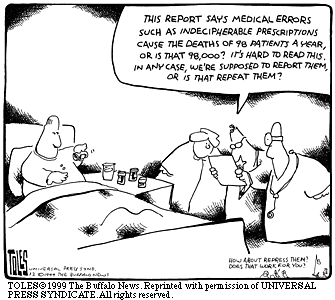 We often note here that quality improvement in hospitals seems excruciatingly slow to happen, and engaged patients and families need to keep their eyes wide open, because sometimes a fix doesn’t require being a genius. For instance, see the cartoon at right – from 1999, when the Institute of Medicine’s famous report To Err is Human documented the high rate of deaths from medical errors in U.S. hospitals. (Not just mistakes, but deaths from mistakes. If accidental death in a hospital isn’t ironic, I don’t know what is.)
We often note here that quality improvement in hospitals seems excruciatingly slow to happen, and engaged patients and families need to keep their eyes wide open, because sometimes a fix doesn’t require being a genius. For instance, see the cartoon at right – from 1999, when the Institute of Medicine’s famous report To Err is Human documented the high rate of deaths from medical errors in U.S. hospitals. (Not just mistakes, but deaths from mistakes. If accidental death in a hospital isn’t ironic, I don’t know what is.)
Nobody likes to think about it, but the vast majority of hospitals haven’t fixed this: a year ago the HHS Inspector General reported that 15,000 Medicare patients a month die from accidental causes. (See Jon Lebkowsky’s post about it, from a Consumers Union Safe Patient Project meeting where he spoke.)
We’re in our 13th year after To Err, yet this morning SPM member Paul Bearman spotted this article by Maura Lerner in the Minneapolis Star Tribune and posted a note on our member listserv. From Paul’s note:
… minor changes resulted in major improvement of a critical element in patient care.
What I love about the story is how intelligent change can be so wonderfully effective. A small tweak reversed critical failures in discharge prescribing. No complex, expensive, and difficult to use technologies were used. Instead there was a basic trust people given the right structure to do the right thing will get it right.
The change agent in this case was Bruce Thompson, the hospital’s pharmacy director. From the article:
He and his colleagues decided to do a spot-check of 37 patients who were discharged from the hospital to nursing homes over three months in 2008 and 2009.
The rate of medication errors: 92 percent. “It was alarming,” he said. Only three of the 37 cases were problem-free.
The most common problems: Hospital physicians had prescribed the wrong doses, duplicate medications or omitted medications. Nearly a third were considered “likely harmful.”
Yikes! 92% wrong?? A third of them (30% of all scripts) likely harmful??
What’s the miracle fix?
…the hospital assigned pharmacists to check the discharge orders before patients are released. Now, if they spot a mistake, they contact the physician and straighten it out.
In nine months, the error rate dropped to “essentially zero percent”… that, in turn, cut the 30-day readmission rate… in half
And, deliciously, this:
The project worked so well, Thompson said, that some doctors now call the pharmacist before they write the discharge orders.
I don’t know if they realized it, but that’s the Lean principle of “quality at the source” – getting it right the first time, instead of checking for errors later.
Nearly zero percent! Nearly total reduction in “likely harmful” prescription errors!
What’s an e-patient to do?
- Check, check, and re-check that everything’s going on – especially pharmacy orders.
- Share the Star Tribune article with your hospital (and nursing home’s) pharmacy staff.
- I personally know of two cases in my own family, in the past year, where medications were overlooked or wrong at discharge.
- In my experience most people are happy to do a simple change that improves things. (And if they aren’t interested, that ought to tell you something about that place.)
Kudos to Bruce Thompson and team at Hennepin County Medical Center – and to all the people there who gladly adopted the change. I bet there’s been at least one funeral prevented already.






Dave – you’re absolutely right that preventing the error is going to be far more effective than inspection after the fact.
The doctor’s original thought is still, in a way, being inspected by the pharmacist before the order is being written.
I hope that the pharmacists aren’t continually finding and fixing the same problems, whether before or after order writing. I hope the doctors are learning from their errors to prevent them in the future.
That pharmacist inspection step is going to be prone to failure, before or after order writing, since 100% human inspection is never 100% effective.
For those who don’t know Mark, he knows what he’s talking about – author of Lean Hospitals, former Fellow at the Lean Enterprise Institute, and consultant on successful Lean quality improvement initiatives at numerous hospitals. He knows what works.
Dave – Kudos to you (& Paul) for highlighting this piece! It’s a great example of the positive impact pharmacists can make when positioned properly in the healthcare system. Unfortunately, these types of stories can get buried, as evidenced by the fact that the ISMP award mentioned was back from their 2010 cycle (http://bit.ly/Aqg7Wf). More importantly, without adequate dissemination it can be difficult for other institutions to benefit from the practices reported here and ultimately to generate improvements for patients.
Hi Kevin – yeah, I noticed that this was a review of cases in 2008 and 2009, so I guess it’s not a surprise that it was a 2010 award…. but it’s odd that it only gets publicized now.
Otoh, the “glass half full” view says thank goodness it’s FINALLY getting publicized. As I said on Twitter, can we get the pharmacist trade to take this global?? Articles in their journals, talks at their conferences??
I appreciate the efforts being made in hospitals, but what about the walking wounded in the clinics. From my own experiences in a large HMO, I finding about 50% errors, and thanks to the pharmacist that caught the last one.